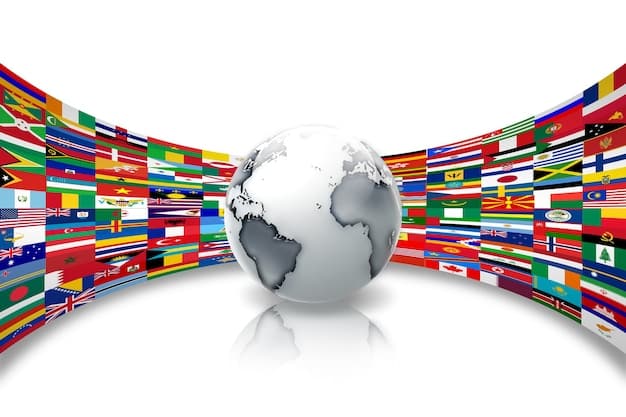E-commerce International Expansion: US Businesses’ Opportunities in New Trade Agreements

E-commerce international expansion presents significant opportunities for US businesses, particularly with new trade agreements reducing barriers and opening access to global markets, enabling increased sales, diversified customer bases, and enhanced competitiveness.
New trade agreements are reshaping the landscape for US businesses, paving the way for unprecedented e-commerce international expansion. These agreements can provide access to new markets for US-based e-commerce businesses.
E-commerce International Expansion: A World of Opportunity
E-commerce knows no borders, and new trade agreements are making international expansion more accessible than ever before for US businesses. These agreements reduce tariffs, streamline customs procedures, and promote regulatory cooperation, creating a more level playing field for international competition.
Understanding the benefits and navigating the complexities of these agreements is crucial for any US e-commerce business looking to tap into the vast potential of the global market.
Understanding New Trade Agreements
Trade agreements are formal pacts between countries that aim to reduce barriers to trade, such as tariffs and quotas. They often include provisions on intellectual property protection, investment, and dispute resolution.
- Lower Tariffs: Many agreements significantly reduce or eliminate tariffs on goods traded between member countries.
- Streamlined Customs: Agreements often simplify customs procedures, making it easier and faster to move goods across borders.
- Regulatory Cooperation: Trade agreements can foster cooperation on regulations, reducing compliance costs and promoting harmonization of standards.

These factors can level the playing field for US companies hoping to extend their reach globally.
Key Trade Agreements for US E-commerce Businesses
Several key trade agreements offer significant opportunities for US e-commerce businesses. These agreements cover a wide range of countries and industries, providing a diverse set of options for expansion.
Some prominent agreements include the US-Mexico-Canada Agreement (USMCA), trade agreements with Asian nations, and potential future agreements with the UK. Let’s dive deeper:
The USMCA and Its E-commerce Provisions
The USMCA replaced NAFTA and includes provisions to facilitate e-commerce, such as ensuring that customs duties are not applied to digital products transmitted electronically.
This is not only beneficial for the US, but for other international partners, as well.
- Digital Products: Prohibits customs duties on digital products, such as software, music, and videos.
- Consumer Protection: Includes provisions to protect consumers from fraud and deceptive practices online.
- Data Flows: Promotes the free flow of data across borders, which is essential for e-commerce businesses.
Opportunities in Asia
The US has trade agreements with several countries in Asia, including South Korea, Singapore, and Australia. These agreements offer preferential access to these markets for US e-commerce businesses.
Asia, as a whole, represent an attractive option for many e-commerce businesses across the US and the rest of the world.
- Growing Markets: Asia is home to some of the fastest-growing e-commerce markets in the world.
- Tech-Savvy Consumers: Asian consumers are increasingly adopting online shopping and mobile payments.
- Regional Hubs: Countries like Singapore serve as regional hubs for e-commerce, providing access to Southeast Asia and beyond.
Navigating International E-commerce Regulations
Expanding internationally requires navigating a complex web of regulations, including import/export restrictions, data privacy laws, and consumer protection rules. Understanding and complying with these regulations is essential for success.
This can be challenging and confusing, but necessary for those hoping to expand globally.
Understanding Import/Export Regulations
Import/export regulations vary widely from country to country. Businesses need to understand the specific requirements of the countries they are exporting to, including tariffs, quotas, and documentation requirements.
Businesses could be subject to significant penalties if they do not meet the requirements.
- Harmonized System (HS) Codes: Use the correct HS codes to classify products for customs purposes.
- Certificates of Origin: Obtain certificates of origin to qualify for preferential tariff rates under trade agreements.
- Customs Brokers: Consider using a customs broker to help navigate complex customs procedures.
Data Privacy and Compliance (GDPR, CCPA)
Data privacy laws, such as the GDPR in Europe and the CCPA in California, have a significant impact on e-commerce businesses. Companies need to ensure that they are complying with these laws when collecting, using, and storing personal data.
Many times, people find that this is a difficult, complicated area to address.
- Privacy Policies: Develop comprehensive privacy policies that disclose how personal data is collected, used, and shared.
- Consent Mechanisms: Obtain valid consent from individuals before collecting or using their personal data.
- Data Security: Implement appropriate security measures to protect personal data from unauthorized access or disclosure.

E-commerce Logistics and Supply Chain Strategies
Efficient logistics and supply chain management are critical for international e-commerce success. Businesses need to optimize their shipping, warehousing, and delivery processes to meet customer expectations and minimize costs.
Businesses will have to have a solid supply chain to provide the services that customers demand.
Optimizing Shipping and Delivery
Shipping and delivery costs can be a significant barrier to international e-commerce. Businesses need to explore different shipping options and negotiate favorable rates with carriers.
Businesses can also work with third-party logistics providers.
- Dimensional Weight Pricing: Understand how carriers calculate shipping costs based on dimensional weight.
- Incoterms: Use Incoterms (International Commercial Terms) to clearly define the responsibilities of buyers and sellers in international transactions.
- Delivery Options: Offer a range of delivery options, including express and standard shipping, to meet different customer needs.
Warehousing and Fulfillment Strategies
Consider using fulfillment centers in key markets to reduce shipping times and costs. Fulfillment centers can handle warehousing, order processing, and shipping.
Without this, businesses can be at a large disadvantage in the e-commerce space.
- Inventory Management: Implement effective inventory management systems to track inventory levels and avoid stockouts.
- Returns Processing: Develop a streamlined returns process to handle customer returns efficiently.
- Localized Packaging: Use localized packaging and labeling to appeal to local customers.
Effective Marketing and Localization Strategies
Effective marketing and localization are essential for reaching international customers. Businesses need to adapt their marketing messages and product offerings to the specific needs and preferences of each target market.
Understanding this is one of the most important areas of international e-commerce.
Adapting Marketing Messages
Translate marketing materials into local languages and adapt them to local cultural norms. Consider using local influencers to promote products and services.
This is key when entering a new foreign marketplace.
- Cultural Sensitivity: Be aware of cultural sensitivities and avoid making assumptions about customer preferences.
- Local SEO: Optimize websites and online listings for local search engines.
- Social Media: Engage with customers on local social media platforms.
Localizing Product Offerings
Adapt product offerings to local preferences and regulations. This may involve changing product sizes, colors, or packaging.
This is a must for most businesses seeking to expand.
- Product Standards: Ensure that products meet local safety and quality standards.
- Currency and Payment Options: Offer products in local currencies and accept local payment methods.
- Customer Support: Provide customer support in local languages.
Leveraging Technology for International E-commerce
Technology plays a critical role in facilitating international e-commerce. Businesses need to leverage the right technology tools to manage multilingual websites, process international payments, and comply with local regulations.
Without the right tools, it is sometimes impossible to do this effectively.
Multilingual Websites and Content Management
Use content management systems (CMS) that support multiple languages. Translate website content and product descriptions into local languages.
This is crucial to connect with customers on a personal level.
- Translation Tools: Use translation tools to automate the translation process.
- Localization Plugins: Install localization plugins to adapt websites to local languages and currencies.
- User Experience: Ensure that multilingual websites provide a seamless user experience for international customers.
International Payment Processing
Partner with payment gateways that support multiple currencies and payment methods. Offer local payment options, such as mobile payments and bank transfers.
Being flexible with payment methods increases buying flexibility for consumers.
- Currency Conversion: Provide transparent currency conversion rates.
- Fraud Prevention: Implement fraud prevention measures to protect against international fraud.
- Compliance: Comply with local payment regulations.
| Key Point | Brief Description |
|---|---|
| 🌏 New Trade Agreements | Lower barriers and tariffs, expanding access to global markets. |
| 📜 Regulatory Compliance | Navigating import/export rules, data privacy (GDPR, CCPA), and consumer protection laws. |
| 🚚 Logistics Optimization | Streamlining shipping, warehousing, and delivery for efficiency and cost reduction. |
| 📢 Marketing Localization | Adapting marketing to local cultures and languages for effective outreach. |
FAQ
▼
Expanding e-commerce internationally allows businesses to access new markets, diversify their customer base, increase sales revenue, and enhance their brand recognition on a global scale. It presents an amazing opportunity.
▼
New trade agreements reduce tariffs and trade barriers, streamline customs procedures, and promote regulatory cooperation. This lowers costs, simplifies logistics, and enables easier access to global markets.
▼
Key regulations include import/export restrictions, data privacy laws like GDPR and CCPA, consumer protection rules, and compliance with local product standards and labeling requirements. You should learn these well.
▼
Optimizing logistics involves exploring various shipping options, negotiating rates, using Incoterms, offering multiple delivery choices, and potentially establishing or utilizing fulfillment centers in key international markets.
▼
Marketing localization adapts content to local languages and cultural norms, enhancing customer engagement. Local SEO, social media engagement, and culturally sensitive messaging are essential for successful international marketing campaigns.
Conclusion
E-commerce international expansion, fueled by new trade agreements, presents a wealth of opportunities for US businesses. By understanding these agreements, navigating regulations, optimizing logistics, localizing marketing, and leveraging technology, businesses can unlock unprecedented growth and success in the global marketplace.





